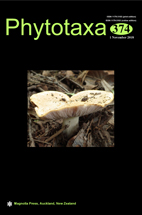Abstract
The name Hymenasplenium laterepens was first proposed by Cheng and Murakami in 1998 but was not validly published. We recently collected and studied this taxon at its locus classicus in Xishuangbanna, Yunnan Province in China. Molecular phylogenetic analyses and morphological observation of H. laterepens and related species clearly indicate that this is a distinct taxonomic entity worthy of species rank. Phylogenetically, H. laterepens is closely related to H. apogamum and may be involved in the reticulate evolution of the H. apogamum complex, which is comprised of several taxa with different levels of ploidy. Morphologically, H. laterepens is distinguished by the combination of its triangular laminae, large pinnae with acute apices and deeply serrated margins, and ca. 117 chromosomes at meiosis I and 32 spores in each sporangium. This work provides a complete species description and comparison to related species within the genus Hymenasplenium, particularly to other relatives of the “H. unilaterale” group. Hymenasplenium laterepens is described here with diagnosis and type designation.

